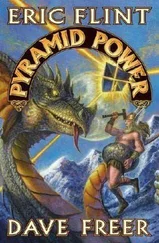“A shame you lost your old boiler suit in that volcano.”
“Yeah.” Costas looked disconsolate for a moment. “It melted. I’ve kept the shreds of it in my cabin on Seaquest . It was great to wear that over my E-suit. I haven’t worked out how to carry tools properly since then.”
Lanowski ducked down and pulled a package out of his own bag and handed it to Costas. “I hope you don’t mind. I took a look at that old one in your cabin to get the size.” He tore open the plastic, and an immaculate blue boiler suit complete with outsized leg and arm pockets came tumbling out.
Costas stared. “Hey, Jacob. You’re the man .” He took the suit and held it out appreciatively. “It’s even the correct pattern, 1954 U.S. Navy submariner issue. Where the hell did you find this?”
Lanowski shrugged. “eBay, of course. You can find everything on eBay. I reckoned you were likely to ditch this one with your E-suit at the end of this mission, so I ordered two. There’s another one hanging up behind the door in your cabin.”
Costas looked at Jack, jerking a thumb at Lanowski. “This guy’s good. Really good. We should have him on all our dives.”
Lanowski glanced at his GPS receiver. “Time to saddle up. I mean it this time.”
Costas grinned and slapped him on the shoulder. “Roger that.”
* * *
Twenty minutes later Jack was floating beside Costas on the starboard side of the felucca, the buoyancy in his E-suit holding him upright with his head and shoulders out of the water. Between them were the aquajets they planned to use to extend their exploration reach underwater. These compact propeller-driven units were capable of 2.5 horsepower with a battery life of up to three hours. The E-suit was an all-environment, Kevlar-reinforced protective shell developed at IMU and refined over the last ten years. It provided a dry interior with temperature control but gave the diver the agility of a wetsuit. Critical to its performance was the streamlined console on the back containing a breathing unit of choice, in this case a semi-closed-circuit oxygen rebreather ideal for maximizing bottom time in the shallow depths they were likely to encounter. The upper part of the console contained a computer that regulated oxygen output, monitored the diver’s physiology, and contained a two-way communication unit, all of it feeding into the helmet with a pivoting visor that was clamped on top of the E-suit. In a refinement since the early days, the helmet was now a closer fit to the head with a flexible neck made of the same material as the E-suit, allowing the diver to move almost without restriction. Jack loved the E-suit for the freedom it gave him, and for the adaptability that allowed them to use it in every conceivable environment, from the Arctic to the superheated water above an underwater volcano to the dive they were about to carry out now, into the murky depths of the Nile, searching for an ancient tunnel under the desert and what might lie beyond.
Lanowski’s head reappeared over the gunwale and he stared down at them. He had prepared a comprehensive equipment checklist on his computer, something that Jack and Costas usually winged, and had just finished running through it with them. Jack could feel the bulge under his E-suit where his Beretta was holstered, and the slight discomfort of the shirt and lightweight jacket, casual trousers, and leather shoes he was wearing under the suit. He was ready to walk out of his E-suit into the streets of Cairo. They had run carefully through every scenario, assessing the best plan of action. Everything depended on them finding the tunnel, being able to get into it, and then finding an egress point. If there was no tunnel below, they would abort the mission here and now. And if there was no egress point farther along the tunnel, they would hope to return to this point, stash their suits in the ruins of the fort, and make their way along the riverbank to the north. As Jack floated there beside the felucca, seeing nothing below, everything seemed to hang in the balance. The yawning uncertainty seemed to eclipse all the hours and days of speculation, the endless juggling of scenarios and possibilities that had filled his mind since finding this spot had become a reality.
Lanowski looked at Costas. “Double-check the two radio beacons.”
“Roger that. One to be activated when we exit, the other when we reach the Nile.”
“And the marker buoy?”
Costas patted the front pocket of the boiler suit he had donned on top of his E-suit. “Roger that. We release it here as soon as we know we can get inside the tunnel.”
“Is your GPS activated?”
“Roger. The in-helmet display will navigate to the precise fix you calculated for the tunnel.”
“Mohammed wants to stand off as soon as possible in the center of the river. He’s the world’s most level guy, as you could see from how cool he was going through Cairo, but he’s gotten twitchy. His son told me that this part of the river has a bad reputation among the felucca captains. They think it’s spooked. Apparently there are whirlpools, and some of the captains think they’re caused by river monsters. Probably nothing to worry about, just giant Nile carp inflated by rumor into monsters.”
“That’s bad enough,” Costas grumbled. “Those things have been known to pull fishermen under.”
“Or it could be crocodiles.”
“Or what ?”
“Crocodiles,” Lanowski said distractedly, looking at his list again. “Apparently, they sometimes get this far. Mostly only small ones these days, but some big carcasses still get washed down. Sometimes they’re not carcasses. Sometimes they’re alive and snapping.” Costas groaned again. “That’s great. I thought we’d left all that behind at the crocodile temple in Sudan. Why didn’t someone tell me?”
“You’d still have volunteered,” Jack said. “You’d never have let me do this alone.”
Mohammed appeared beside Lanowski, looking anxious. “Okay, boys,” Lanowski said. “You’ve got to go. See you back on board in a few hours, inshallah.”
“Thanks, Jacob. Look after yourself. No shore expeditions, remember?” Jack turned to Costas. “Good to go?”
Costas made a diver’s okay signal. “Good to go.” They both shut their visors, and Jack felt the slight increase in pressure as the helmet sealed and the rebreather came online. A second later the in-helmet screen display activated to the left and right of his main viewport. It was a low-light readout that could show up to thirty variables, from carbon dioxide levels to pulse rate. He tapped the computer control inside the index finger of his left glove and reduced the display to the minimum, to show depth in meters, compass orientation, and external water temperature. He raised his right arm in an okay signal to Lanowki and Mohammed, then turned and did a thumbs-down signal to Costas. He descended two meters, bleeding off air manually from his suit and waiting for the automated buoyancy system to compensate. He pulled down the aquajet after him and waited while its computer altered the trim in the small ballast tanks on either side of the unit, an automated process that self-adjusted with depth to ensure that the scooter remained neutrally buoyant.
He switched on his helmet light but was dazzled by the reflection of particles in the water that reduced the visibility to almost zero. He switched it off and was again in blackness, the moonless night meaning that no light filtered down from the surface. As he stared out, he remembered the lines that Jeremy had read from Howard Carter’s diary, the account that Carter had heard from Corporal Jones of what went on here that night in 1892 when Colonel Chaillé-Long and the French diver had accompanied Jones to this very spot. He could well imagine the trepidation of the diver as he went down with his homemade gear, yet also his excitement at seeing that the valve and cylinder worked and at what he might discover on the riverbed below.
Читать дальше












